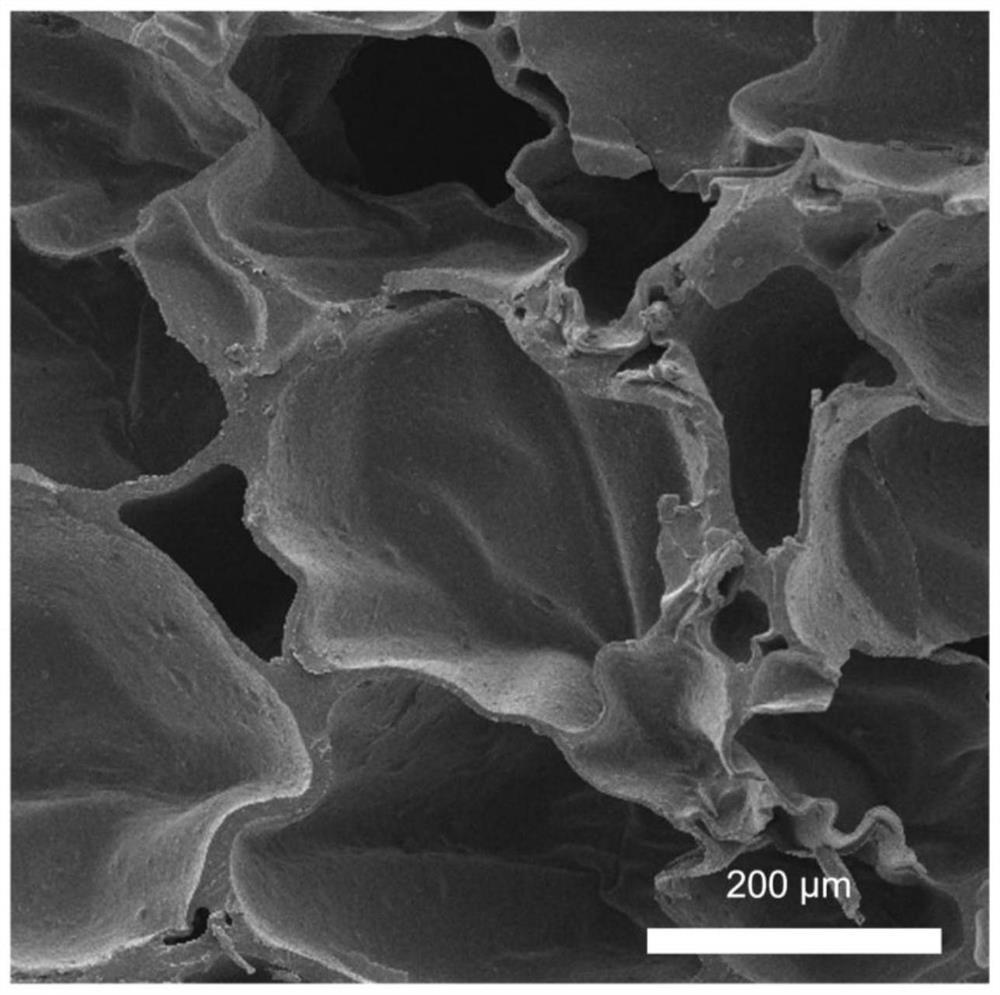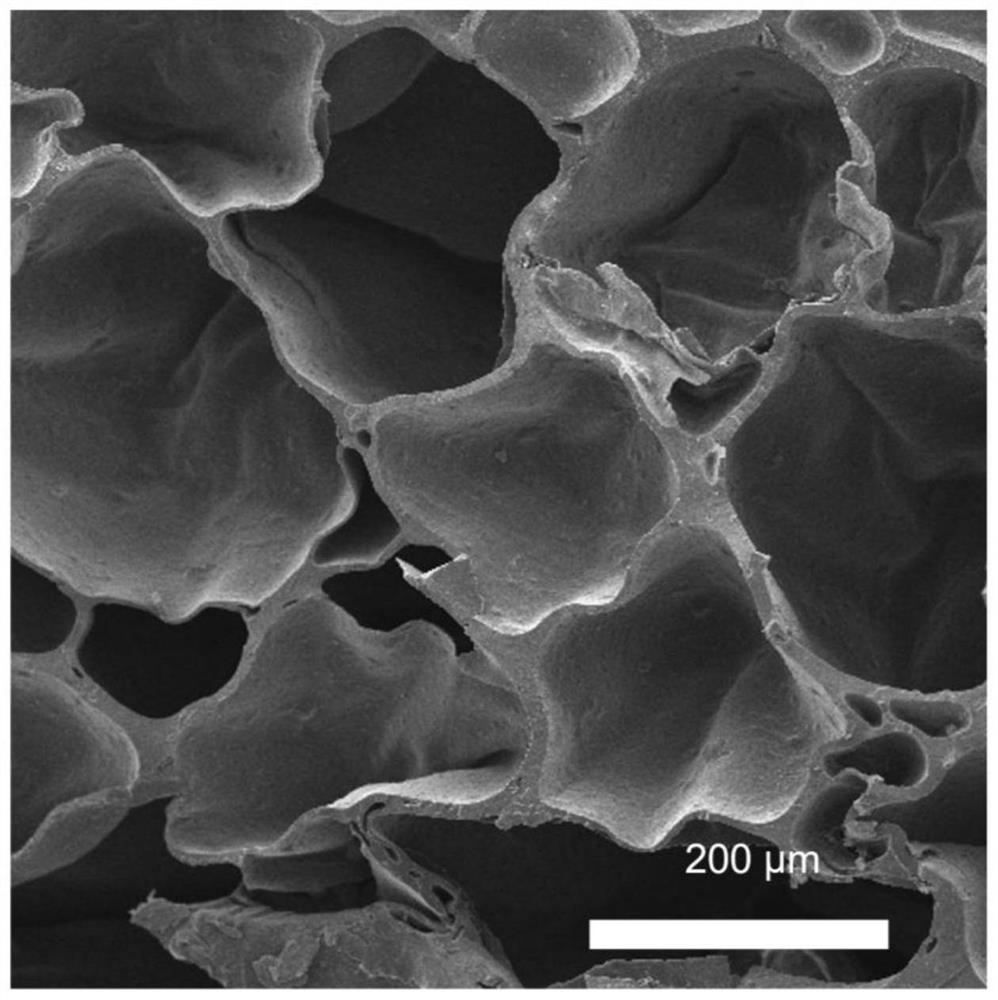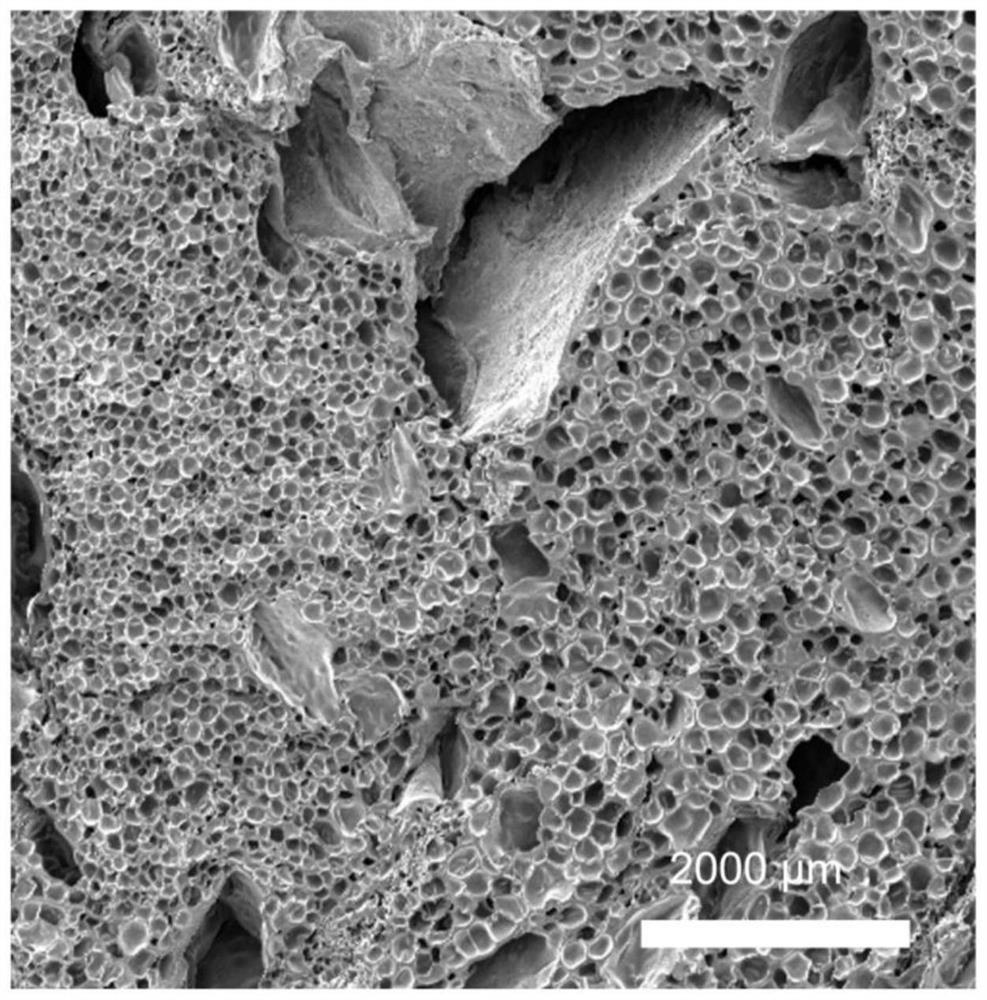Degradable foam material and preparation method thereof
A foaming material and foaming agent technology, applied in the field of foaming materials, can solve problems such as low melt strength, poor cell structure and comprehensive mechanical properties, and achieve improved melt strength, cell uniformity and foaming The effect of high foam stability, ductility and comprehensive mechanical properties
- Summary
- Abstract
- Description
- Claims
- Application Information
AI Technical Summary
Problems solved by technology
Method used
Image
Examples
Embodiment 1
[0058] Embodiment 1: A kind of degradable foaming material, by mass parts, comprises the following components:
[0059] 70 parts of polybutylene adipate-terephthalate;
[0060] 20 parts of polylactic acid;
[0061] 5 parts of porous inorganic particle photosensitizer;
[0062] 5 parts of AC foaming agent;
[0063] Chain extender ADR-4370S 1.5 parts;
[0064] 1.5 parts of compatibilizer glyceryl triacetate;
[0065] 1.5 parts of co-crosslinking agent 1,4-butanediol diacrylate;
[0066] Antioxidant DLTP 0.7 parts;
[0067] Antioxidant 1010 0.7 parts;
[0068] 10 parts of multi-epoxy modified starches;
[0069] Wherein the porous inorganic particle photosensitizer, the preparation method comprises:
[0070] (1) Place KH550 in an ethanol-water mixture to prepare a 2wt% ammonia silane coupling agent solution;
[0071] (2) Disperse mesoporous silica in an ammonia-based silane coupling agent solution, stir and react for 5 hours, take the precipitate, and dry it at 100°C to p...
Embodiment 2
[0078] Embodiment 2: A kind of degradable foaming material, by mass parts, comprises the following components:
[0079] 60 parts of polyadipate-butylene terephthalate;
[0080] 30 parts of polylactic acid;
[0081] 5 parts of porous inorganic particle photosensitizer;
[0082] 8 parts of AC foaming agent;
[0083] Chain extender ADR-4370S 1.5 parts;
[0084] 1.5 parts of compatibilizer glyceryl triacetate;
[0085] 2 parts of auxiliary crosslinking agent pentaerythritol triacrylate;
[0086] Antioxidant DLTP 0.7 part;
[0087] Antioxidant 1010 0.7 parts;
[0088] 10 parts of multi-epoxy modified starches;
[0089] Wherein the porous inorganic particle photosensitizer, the preparation method comprises:
[0090] (1) placing KH540 in an ethanol-water mixture to prepare a 2wt% ammonia silane coupling agent solution;
[0091] (2) Disperse the hydrotalcite in the ammonia-based silane coupling agent solution, stir and react for 6 hours, take the precipitate, and dry it at 11...
Embodiment 3
[0098] Embodiment 3: A kind of degradable foaming material, by mass parts, comprises the following components:
[0099] 50 parts of polyadipate-butylene terephthalate;
[0100] 40 parts of polylactic acid;
[0101] 5 parts of porous inorganic particle photosensitizer;
[0102] 8 parts of AC foaming agent;
[0103] Chain extender ADR-4370S 1.5 parts;
[0104] 1.5 parts of compatibilizer glyceryl triacetate;
[0105] 2 parts of auxiliary crosslinking agent pentaerythritol triacrylate;
[0106] Antioxidant DLTP 0.7 part;
[0107] Antioxidant 1010 0.7 parts;
[0108] 10 parts of thermoplastic starch masterbatch;
[0109] Wherein the porous inorganic particle photosensitizer, the preparation method comprises:
[0110] (1) placing KH792 in an ethanol-water mixture to prepare a 5wt% ammonia silane coupling agent solution;
[0111] (2) Disperse the clay in an ammonia-based silane coupling agent solution, stir and react for 6 hours, take the precipitate, and dry it at 110°C to...
PUM
| Property | Measurement | Unit |
|---|---|---|
| melting point | aaaaa | aaaaa |
Abstract
Description
Claims
Application Information
 Login to View More
Login to View More - R&D
- Intellectual Property
- Life Sciences
- Materials
- Tech Scout
- Unparalleled Data Quality
- Higher Quality Content
- 60% Fewer Hallucinations
Browse by: Latest US Patents, China's latest patents, Technical Efficacy Thesaurus, Application Domain, Technology Topic, Popular Technical Reports.
© 2025 PatSnap. All rights reserved.Legal|Privacy policy|Modern Slavery Act Transparency Statement|Sitemap|About US| Contact US: help@patsnap.com



